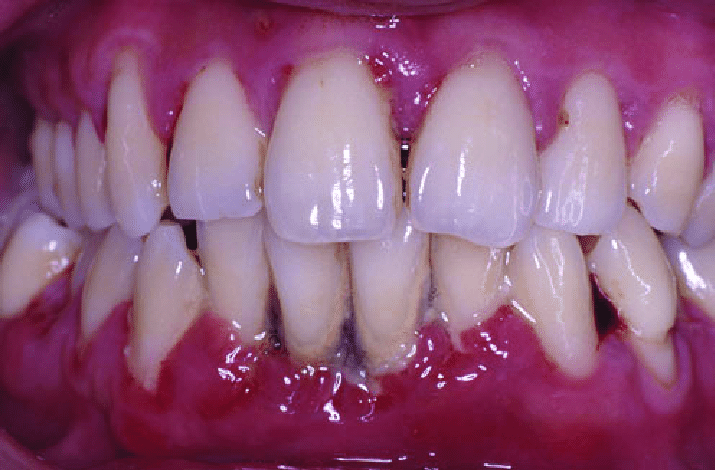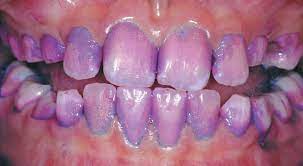
Purple gums can be a sign of a number of different conditions. Here are a few possibilities:
- Purpura: This is a condition that causes bruising and bleeding under the skin, including in the gums. It can be caused by a variety of factors, including certain medications, infections, and underlying medical conditions such as autoimmune disorders or blood disorders.
- Vitamin deficiency: A deficiency in certain nutrients, such as vitamin C or iron, can cause gums to appear purple or blue.
- Acute necrotizing ulcerative gingivitis: This is a severe gum infection that can cause gums to become red, swollen, and painful. It can also cause gums to appear purple or black.
- Oral cancer: In rare cases, purple gums can be a sign of oral cancer.
If you are experiencing purple gums, it is important to speak with a healthcare provider for a proper diagnosis and treatment.
What Is Purple Gums:
Purple gums are a condition in which the gums appear to be purple or dark in color. As mentioned above, there are a number of different conditions that can cause the gums to appear purple. Some of these conditions, such as purpura and vitamin deficiencies, are relatively benign and can be easily treated. Others, such as acute necrotizing ulcerative gingivitis and oral cancer, can be more serious and may require more intensive treatment.
It is important to speak with a healthcare provider if you are experiencing purple gums or any other changes in the appearance of your gums. They can perform an examination and possibly order tests to determine the cause of the change and the appropriate course of treatment.
Purple Gums Introduction?
Purple gums, also known as purple gingiva, is a condition in which the gums appear purplish in color. The gums are the soft tissues that surround and support the teeth. They are usually pink in color, but can appear purple due to a number of factors.
Purple gums can be a sign of an underlying medical condition or a result of certain medications or habits. Some common causes of purple gums include:
- Anemia: Anemia is a condition in which there is a deficiency of red blood cells or hemoglobin in the body. This can cause the gums to appear pale or purplish in color.
- Poor circulation: Gums that are purple due to poor circulation may feel cold to the touch and may be painful.
- Certain medications: Some medications, such as blood thinners, can cause the gums to appear purple.
- Trauma: Injuries or trauma to the gums can cause them to appear purple.
- Smoking: Smoking can cause the gums to appear purple or dark in color.
It is important to speak with a healthcare provider if you notice any changes in the color of your gums or if you have any other concerns about your oral health. A healthcare provider can determine the cause of the purple gums and recommend the appropriate treatment.
Purple Gums Pros:
There are no known pros or benefits to having purple gums. Purple gums can be a sign of an underlying medical condition or a result of certain medications or habits, and it is important to speak with a healthcare provider if you notice any changes in the color of your gums or if you have any other concerns about your oral health. A healthcare provider can determine the cause of the purple gums and recommend the appropriate treatment.
It is important to take care of your oral health, including brushing and flossing regularly, and visiting a dentist regularly for check-ups and cleanings. This can help prevent the development of issues such as gum disease, which can lead to a range of problems including tooth loss, gum recession, and even an increased risk of heart disease and stroke.
Cons:
Purple gums can be a sign of an underlying medical condition or a result of certain medications or habits, and it is important to speak with a healthcare provider if you notice any changes in the color of your gums or if you have any other concerns about your oral health. Some potential cons or negative effects of purple gums include:
- Pain: Purple gums may be painful or tender to the touch.
- Infection: If purple gums are caused by an underlying condition such as gum disease, there may be an increased risk of infection.
- Tooth loss: Gum disease can lead to tooth loss if left untreated.
- Gum recession: Purple gums may be a sign of gum recession, which is the loss of gum tissue around the teeth.
- Increased risk of other health problems: Gum disease has been linked to an increased risk of heart disease and stroke, as well as other health problems.
It is important to speak with a healthcare provider if you notice any changes in the color of your gums or if you have any other concerns about your oral health. A healthcare provider can determine the cause of the purple gums and recommend the appropriate treatment.
Conclusion:
In conclusion, purple gums can be a sign of an underlying medical condition or a result of certain medications or habits. It is important to speak with a healthcare provider if you notice any changes in the color of your gums or if you have any other concerns about your oral health. A healthcare provider can determine the cause of the purple gums and recommend the appropriate treatment. It is also important to take care of your oral health by brushing and flossing regularly, and visiting a dentist regularly for check-ups and cleanings. This can help prevent the development of issues such as gum disease and the potential negative effects that can result from it.




